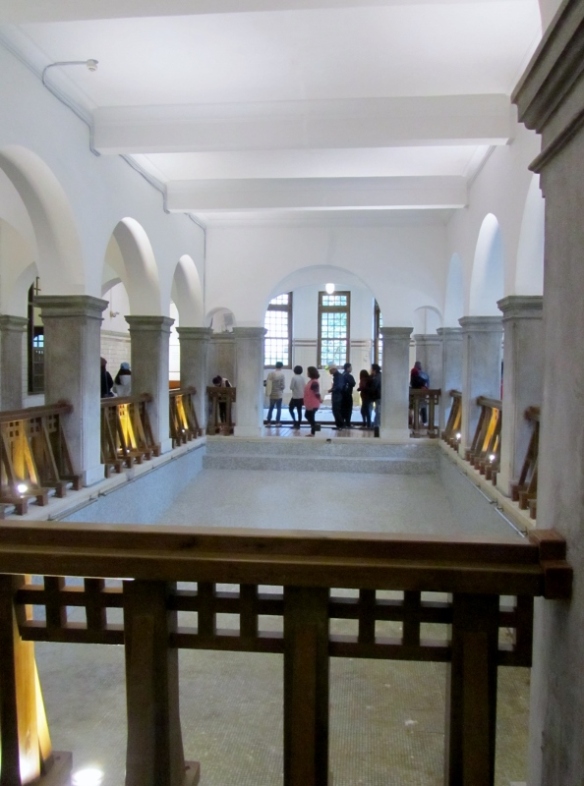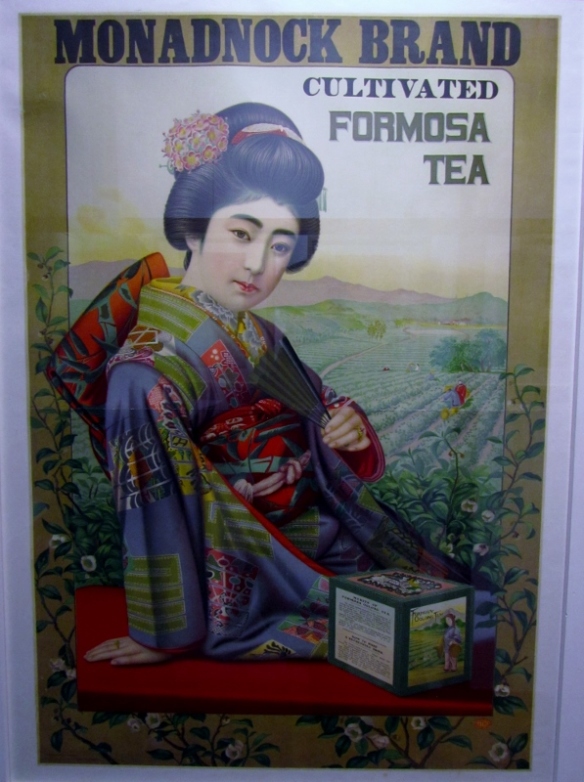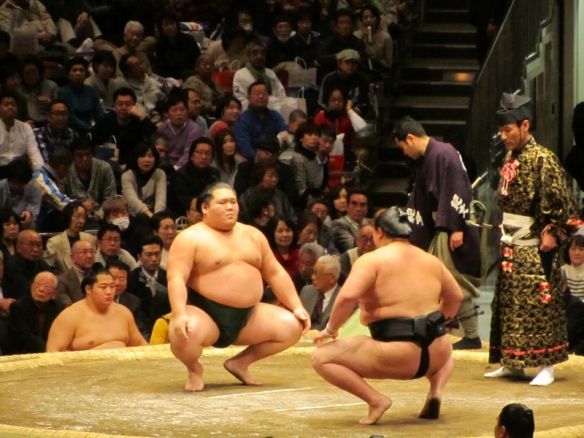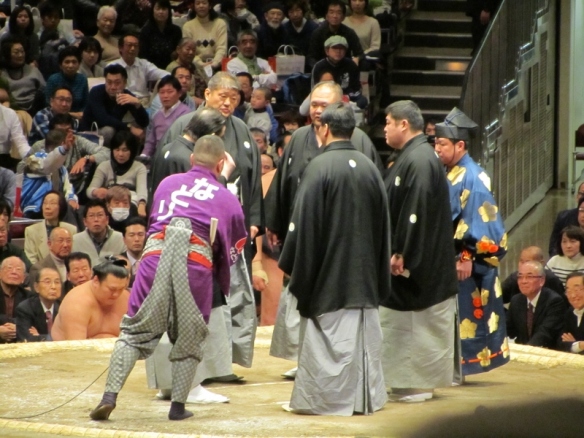Taiwan came under Japanese control in 1895 after Japan won the First Sino-Japanese War, and for the next 50 years Taiwan was a Japanese colony. During this time the Japanese were met with armed resistance as they extended their control south into indigenous territory, but Japanese colonial history and heritage still has a visible presence in northern Taiwan. Beitou, a district in the north of Taipei was developed by the Japanese from a small village to a popular hot spring resort due to the many sulfurous natural springs in the area.
 We didn’t bathe in a hot spring, but we did visit the Beitou Hot Spring Museum, which was built in the early 1910s, in Japanese colonial style. It was a very grand building, with a large Roman-style bath, stained-glass windows and a tatami-floored second floor. The exhibits at the building ranged from the geological and geothermal characteristics of the surrounding area, to Japanese traditions of sanitation, to an exhibition of post-war Taiwanese cinema.
We didn’t bathe in a hot spring, but we did visit the Beitou Hot Spring Museum, which was built in the early 1910s, in Japanese colonial style. It was a very grand building, with a large Roman-style bath, stained-glass windows and a tatami-floored second floor. The exhibits at the building ranged from the geological and geothermal characteristics of the surrounding area, to Japanese traditions of sanitation, to an exhibition of post-war Taiwanese cinema.


 I loved the illustrated explanation of Taiwanese film tropes, from the generic to the very specific.
I loved the illustrated explanation of Taiwanese film tropes, from the generic to the very specific.
 Nearby there is also the Beitou Plum Garden, the summer residence of calligrapher Yu Youren. It was built in the 1930s, with the lower floor built of reinforced concrete to act as an air raid shelter, and the upper floor built of wood in traditional Japanese style. It became the home of Yu Youren in the 1950s when he moved with the Chinese Nationalist Party to Taiwan. I don’t remember there being many English explanations in the building, which is a pity because the meaning of the poetry was lost on me, but I could appreciate the beauty of his calligraphy and the furnishings were very evocative of a Chinese nostalgia.
Nearby there is also the Beitou Plum Garden, the summer residence of calligrapher Yu Youren. It was built in the 1930s, with the lower floor built of reinforced concrete to act as an air raid shelter, and the upper floor built of wood in traditional Japanese style. It became the home of Yu Youren in the 1950s when he moved with the Chinese Nationalist Party to Taiwan. I don’t remember there being many English explanations in the building, which is a pity because the meaning of the poetry was lost on me, but I could appreciate the beauty of his calligraphy and the furnishings were very evocative of a Chinese nostalgia.
 For Japanese colonial nostalgia, see the Beitou Museum. The two-story Japanese-style wooden building was built in 1921 as a hot spring resort called the Kazan Hotel. It is located further away from the town of Beitou, up the mountains, surrounded by trees. It changed functions over the years, but during the second world war it was used as lodging for kamikaze pilots. The museum collections and exhibitions contain both Japanese and indigenous Taiwanese crafts, and during our visit the exhibitions were focused on tea, with many Japanese tea ceremony utensils on display, as well as old advertising posters for ‘Formosa Tea.’ The museum’s tea room is a beautiful place to have some Taiwanese-style oolong or jasmine tea, looking out onto the tree-covered hills. Though every now and then the sulphurous fumes of the hot springs waft through.
For Japanese colonial nostalgia, see the Beitou Museum. The two-story Japanese-style wooden building was built in 1921 as a hot spring resort called the Kazan Hotel. It is located further away from the town of Beitou, up the mountains, surrounded by trees. It changed functions over the years, but during the second world war it was used as lodging for kamikaze pilots. The museum collections and exhibitions contain both Japanese and indigenous Taiwanese crafts, and during our visit the exhibitions were focused on tea, with many Japanese tea ceremony utensils on display, as well as old advertising posters for ‘Formosa Tea.’ The museum’s tea room is a beautiful place to have some Taiwanese-style oolong or jasmine tea, looking out onto the tree-covered hills. Though every now and then the sulphurous fumes of the hot springs waft through.


 Back in the city, The Red House is a Japanese Western-style octagonal red brick market built in 1908. It has become a creative space in recent years, with independent boutiques, cultural events and creative workshops. The octagonal entrance has a small exhibition of the history of the building, and the walls are decorated with the type of goods that were imported for the Japanese living in colonial Taipei and sold in the market.
Back in the city, The Red House is a Japanese Western-style octagonal red brick market built in 1908. It has become a creative space in recent years, with independent boutiques, cultural events and creative workshops. The octagonal entrance has a small exhibition of the history of the building, and the walls are decorated with the type of goods that were imported for the Japanese living in colonial Taipei and sold in the market.

 The wrestlers arriving.
The wrestlers arriving.
 Endō in his keshō-mawashi apron depicting the gate of Kanazawa Station during the ring-entering ceremony.
Endō in his keshō-mawashi apron depicting the gate of Kanazawa Station during the ring-entering ceremony.




 There are quite a few foreign wrestlers, the most famous being the Mongolian Hakuhō Shō who holds the record for the most undefeated tournament championships. I can’t remember who this wrestler is, but there are some high-ranking wrestlers from Hungary, Bulgaria and Georgia.
There are quite a few foreign wrestlers, the most famous being the Mongolian Hakuhō Shō who holds the record for the most undefeated tournament championships. I can’t remember who this wrestler is, but there are some high-ranking wrestlers from Hungary, Bulgaria and Georgia.


 After both of the wrestlers had tumbled off the platform onto some people sitting at the front (luckily no one was injured), the referees and judges conferred over the winner.
After both of the wrestlers had tumbled off the platform onto some people sitting at the front (luckily no one was injured), the referees and judges conferred over the winner. Because it was the first day of the tournament, the Emperor and Empress came to watch.
Because it was the first day of the tournament, the Emperor and Empress came to watch.

 We didn’t bathe in a hot spring, but we did visit the Beitou Hot Spring Museum, which was built in the early 1910s, in Japanese colonial style. It was a very grand building, with a large Roman-style bath, stained-glass windows and a tatami-floored second floor. The exhibits at the building ranged from the geological and geothermal characteristics of the surrounding area, to Japanese traditions of sanitation, to an exhibition of post-war Taiwanese cinema.
We didn’t bathe in a hot spring, but we did visit the Beitou Hot Spring Museum, which was built in the early 1910s, in Japanese colonial style. It was a very grand building, with a large Roman-style bath, stained-glass windows and a tatami-floored second floor. The exhibits at the building ranged from the geological and geothermal characteristics of the surrounding area, to Japanese traditions of sanitation, to an exhibition of post-war Taiwanese cinema.

 I loved the illustrated explanation of Taiwanese film tropes, from the generic to the very specific.
I loved the illustrated explanation of Taiwanese film tropes, from the generic to the very specific. Nearby there is also the Beitou Plum Garden, the summer residence of calligrapher Yu Youren. It was built in the 1930s, with the lower floor built of reinforced concrete to act as an air raid shelter, and the upper floor built of wood in traditional Japanese style. It became the home of Yu Youren in the 1950s when he moved with the Chinese Nationalist Party to Taiwan. I don’t remember there being many English explanations in the building, which is a pity because the meaning of the poetry was lost on me, but I could appreciate the beauty of his calligraphy and the furnishings were very evocative of a Chinese nostalgia.
Nearby there is also the Beitou Plum Garden, the summer residence of calligrapher Yu Youren. It was built in the 1930s, with the lower floor built of reinforced concrete to act as an air raid shelter, and the upper floor built of wood in traditional Japanese style. It became the home of Yu Youren in the 1950s when he moved with the Chinese Nationalist Party to Taiwan. I don’t remember there being many English explanations in the building, which is a pity because the meaning of the poetry was lost on me, but I could appreciate the beauty of his calligraphy and the furnishings were very evocative of a Chinese nostalgia. For Japanese colonial nostalgia, see the
For Japanese colonial nostalgia, see the 

 Back in the city,
Back in the city, 